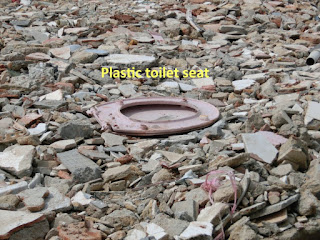The video embedded in my previous blog post shows contractor destroying my good soil by pressing all sorts of demolition debris on it. Someone asks whether this is a standard practice among the construction/landscape contractors in Singapore. Well, if it is not standard, it is certainly common. A well-known case is the ACRES Vs ANA Contractor case. I have also heard of cases concerning landed properties whose gardens were spoiled due to landscape contractors burying hazardous materials under the soil. To the contractors, it makes financial sense to "reuse" those waste materials, but it is detrimental to the soil, on which we can grow our food.
Anyone who engages construction/landscape contractors must be very vigilant. Once the soil is damaged or contaminated, it takes years and a lot of money to clean up.
I was involved in insect surveys in a forested area recently. It is heart-sinking to see so much construction wastes dumped randomly in the forests.
I understand that most of the forests (a huge piece of land) are to be destroyed for development, but thoughtless dumping of construction waste must be controlled. In the development project, there would be areas reserved for green spaces (gardens and parks). If the random dumping of wastes is allowed, it is hard in the future to find clean soil for creating parks and gardens.
It is already well-known that Singapore is not a clean city, but a cleaned city. It is very common to see pavements, lawns and even parks littered with rubbish like cigarette butts, plastic cups, packets, bottles, etc., and National Day rubbish too.
In Ground-Up Initiative, volunteers would sometimes help to collect dry leaves from around the premises to be used as mulching materials in our food garden. But often, there is so much rubbish among the dry leaves that everything has to be dumped as general waste and sent to the incinerators.
It is very sad.
Soil health is human health. We are what we eat and what we eat comes from the soil.
Anyone who engages construction/landscape contractors must be very vigilant. Once the soil is damaged or contaminated, it takes years and a lot of money to clean up.
I was involved in insect surveys in a forested area recently. It is heart-sinking to see so much construction wastes dumped randomly in the forests.
I understand that most of the forests (a huge piece of land) are to be destroyed for development, but thoughtless dumping of construction waste must be controlled. In the development project, there would be areas reserved for green spaces (gardens and parks). If the random dumping of wastes is allowed, it is hard in the future to find clean soil for creating parks and gardens.
It is already well-known that Singapore is not a clean city, but a cleaned city. It is very common to see pavements, lawns and even parks littered with rubbish like cigarette butts, plastic cups, packets, bottles, etc., and National Day rubbish too.
In Ground-Up Initiative, volunteers would sometimes help to collect dry leaves from around the premises to be used as mulching materials in our food garden. But often, there is so much rubbish among the dry leaves that everything has to be dumped as general waste and sent to the incinerators.
It is very sad.
Soil health is human health. We are what we eat and what we eat comes from the soil.
Franklin Delano Roosevelt (32nd U.S. President) once said: "The nation that destroys its soil, destroys itself."







